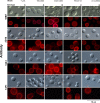Immunomodulatory effects of serotype B glucuronoxylomannan from Cryptococcus gattii correlate with polysaccharide diameter
- PMID: 20547742
- PMCID: PMC2937472
- DOI: 10.1128/IAI.00111-10
Immunomodulatory effects of serotype B glucuronoxylomannan from Cryptococcus gattii correlate with polysaccharide diameter
Abstract
Glucuronoxylomannan (GXM), the major capsular component in the Cryptococcus complex, interacts with the immune system in multiple ways, which include the activation of Toll-like receptors (TLRs) and the modulation of nitric oxide (NO) production by phagocytes. In this study, we analyzed several structural parameters of GXM samples from Cryptococcus neoformans (serotypes A and D) and Cryptococcus gattii (serotypes B and C) and correlated them with the production of NO by phagocytes and the activation of TLRs. GXM fractions were differentially recognized by TLR2/TLR1 (TLR2/1) and TLR2/6 heterodimers expressed on TLR-transfected HEK293A cells. Higher NF-kappaB luciferase reporter activity induced by GXM was observed in cells expressing TLR2/1 than in cells transfected with TLR2/6 constructs. A serotype B GXM from C. gattii was the most effective polysaccharide fraction activating the TLR-mediated response. This serotype B polysaccharide, which was also highly efficient at eliciting the production of NO by macrophages, was similar to the other GXM samples in monosaccharide composition, zeta potential, and electrophoretic mobility. However, immunofluorescence with four different monoclonal antibodies and dynamic light-scattering analysis revealed that the serotype B GXM showed particularities in serological reactivity and had the smallest effective diameter among the GXM samples analyzed in this study. Fractionation of additional serotype B GXMs, followed by exposure of these fractions to macrophages, revealed a correlation between NO production and reduced effective diameters. Our results demonstrate a great functional diversity in GXM samples from different isolates and establish their abilities to differentially activate cellular responses. We propose that serological properties as well as physical chemical parameters, such as the diameter of polysaccharide molecules, may potentially influence the inflammatory response against Cryptococcus spp. and may contribute to the differences in granulomatous inflammation between cryptococcal species.
Figures







Similar articles
-
Dectin-3 Recognizes Glucuronoxylomannan of Cryptococcus neoformans Serotype AD and Cryptococcus gattii Serotype B to Initiate Host Defense Against Cryptococcosis.Front Immunol. 2018 Aug 6;9:1781. doi: 10.3389/fimmu.2018.01781. eCollection 2018. Front Immunol. 2018. PMID: 30131805 Free PMC article.
-
Toll-like receptor 4 mediates intracellular signaling without TNF-alpha release in response to Cryptococcus neoformans polysaccharide capsule.J Immunol. 2001 Apr 1;166(7):4620-6. doi: 10.4049/jimmunol.166.7.4620. J Immunol. 2001. PMID: 11254720
-
Evasion of Innate Immune Responses by the Highly Virulent Cryptococcus gattii by Altering Capsule Glucuronoxylomannan Structure.Front Cell Infect Microbiol. 2016 Jan 6;5:101. doi: 10.3389/fcimb.2015.00101. eCollection 2015. Front Cell Infect Microbiol. 2016. PMID: 26779451 Free PMC article.
-
The cellular responses induced by the capsular polysaccharide of Cryptococcus neoformans differ depending on the presence or absence of specific protective antibodies.Curr Mol Med. 2005 Jun;5(4):413-20. doi: 10.2174/1566524054022585. Curr Mol Med. 2005. PMID: 15977997 Review.
-
Immunomodulatory Role of Capsular Polysaccharides Constituents of Cryptococcus neoformans.Front Med (Lausanne). 2019 Jun 19;6:129. doi: 10.3389/fmed.2019.00129. eCollection 2019. Front Med (Lausanne). 2019. PMID: 31275938 Free PMC article. Review.
Cited by
-
Allergen1 regulates polysaccharide structure in Cryptococcus neoformans.Mol Microbiol. 2013 May;88(4):713-27. doi: 10.1111/mmi.12216. Epub 2013 Apr 9. Mol Microbiol. 2013. PMID: 23565821 Free PMC article.
-
Neutron Scattering Analysis of Cryptococcus neoformans Polysaccharide Reveals Solution Rigidity and Repeating Fractal-like Structural Patterns.Biomacromolecules. 2024 Feb 12;25(2):690-699. doi: 10.1021/acs.biomac.3c00911. Epub 2023 Dec 29. Biomacromolecules. 2024. PMID: 38157431 Free PMC article.
-
Adjuvant Curdlan Contributes to Immunization against Cryptococcus gattii Infection in a Mouse Strain-Specific Manner.Vaccines (Basel). 2022 Apr 15;10(4):620. doi: 10.3390/vaccines10040620. Vaccines (Basel). 2022. PMID: 35455369 Free PMC article.
-
Pro-inflammatory response ensured by LPS and Pam3CSK4 in RAW 264.7 cells did not improve a fungistatic effect on Cryptococcus gattii infection.PeerJ. 2020 Nov 25;8:e10295. doi: 10.7717/peerj.10295. eCollection 2020. PeerJ. 2020. PMID: 33304649 Free PMC article.
-
Animal Models of Cryptococcus neoformans in Identifying Immune Parameters Associated With Primary Infection and Reactivation of Latent Infection.Front Immunol. 2020 Sep 15;11:581750. doi: 10.3389/fimmu.2020.581750. eCollection 2020. Front Immunol. 2020. PMID: 33042164 Free PMC article. Review.
References
-
- Bicanic, T., and T. S. Harrison. 2004. Cryptococcal meningitis. Br. Med. Bull. 72:99-118. - PubMed
-
- Biondo, C., A. Midiri, L. Messina, F. Tomasello, G. Garufi, M. R. Catania, M. Bombaci, C. Beninati, G. Teti, and G. Mancuso. 2005. MyD88 and TLR2, but not TLR4, are required for host defense against Cryptococcus neoformans. Eur. J. Immunol. 35:870-878. - PubMed
-
- Casadevall, A., W. Cleare, M. Feldmesser, A. Glatman-Freedman, D. L. Goldman, T. R. Kozel, N. Lendvai, J. Mukherjee, L. A. Pirofski, J. Rivera, A. L. Rosas, M. D. Scharff, P. Valadon, K. Westin, and Z. Zhong. 1998. Characterization of a murine monoclonal antibody to Cryptococcus neoformans polysaccharide that is a candidate for human therapeutic studies. Antimicrob. Agents Chemother. 42:1437-1446. - PMC - PubMed
-
- Casadevall, A., J. Mukherjee, and M. D. Scharff. 1992. Monoclonal antibody based ELISAs for cryptococcal polysaccharide. J. Immunol. Methods 154:27-35. - PubMed
-
- Chiapello, L. S., J. L. Baronetti, A. P. Garro, M. F. Spesso, and D. T. Masih. 2008. Cryptococcus neoformans glucuronoxylomannan induces macrophage apoptosis mediated by nitric oxide in a caspase-independent pathway. Int. Immunol. 20:1527-1541. - PubMed
Publication types
MeSH terms
Substances
Grants and funding
- R01 AI033142/AI/NIAID NIH HHS/United States
- G12 RR008124/RR/NCRR NIH HHS/United States
- R01 AI033774/AI/NIAID NIH HHS/United States
- R01 HL059842/HL/NHLBI NIH HHS/United States
- HL059842/HL/NHLBI NIH HHS/United States
- R37 AI033142/AI/NIAID NIH HHS/United States
- 5G12RR008124-16A1S1/RR/NCRR NIH HHS/United States
- AI033142/AI/NIAID NIH HHS/United States
- AI033774/AI/NIAID NIH HHS/United States
- 5G12RR008124-16A1/RR/NCRR NIH HHS/United States
- R01 AI052733/AI/NIAID NIH HHS/United States
- AI052733/AI/NIAID NIH HHS/United States
- T32 GM007491/GM/NIGMS NIH HHS/United States
LinkOut - more resources
Full Text Sources
Miscellaneous

